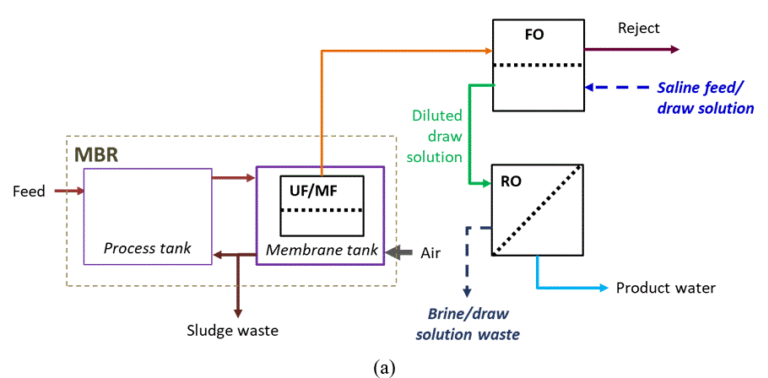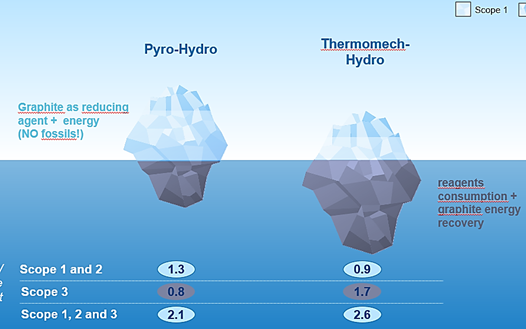Going forward with osmosis
Simon Judd has over 35 years’ post-doctorate experience in all aspects of water and wastewater treatment technology, both in academic and industrial R&D. He has (co-)authored six book titles and over 200 peer-reviewed publications in water and wastewater treatment.
Some things, it seems, work well together: Bob Hope and Bing Crosby, pasta and cheese, Fernando Torres and Steve Gerrard − there are probably thousands of examples across dozens of media or scenarios.
In the more humdrum world of wastewater treatment there are also examples of the combination of two unit processes elegantly meeting some treatment objective. The MLE (Modified Ludzak Ettinger) process combines denitrification with downstream nitrification for N removal, simply by recycling the sludge from one part of the process to another. The combination of screening and degritting, if appropriately designed, effectively protects downstream processes from rags and large abrasive particles − the importance of which is becoming increasingly evident (see blog Degritting in MBRs − true grit costs).
But it also appears that this extends to the achievement of pollutant removal objectives across different streams, with specific reference to energy and/or cost reduction. So, for instance, the cost effectiveness of the much-vaunted algal technology for biofuel generation − while being highly sensitive to the cost of conventional mineral oil supply − can be improved, at least in principle, if the CO2 feed is from a flue gas source and the nutrients from wastewater. The algal ponds or photobioreactors would then need to be located close to both power generation wastewater treatment plants, which obviously presents a few logistical challenges. This is analogous to the case of thermal desalination in the Arabian Gulf which, notwithstanding the low cost of energy in that region, is made viable by combining with power generation plants from which the waste, low-pressure steam can be harnessed for evaporation.
And it would seem that a similar challenge may apply to another new-ish technology, heralded as the future of desalination, forward osmosis (FO). As with algal technology, a huge amount of research has been conducted in FO over the past 15−20 years without a great deal of implementation. The root of the lack of enthusiasm for the technology by the practitioners would appear to simply come down to the costs: FO, for the honey-pot application of seawater desalination, is simply more expensive than conventional RO.
This comes down to the nature of the process. FO purifies feedwater by drawing pure water into a concentrated draw solution − often a simple brine solution. The water then has somehow to be extracted from the draw solution. And very often, this is by RO. So, it’s not easy to spot the constraint placed on this process: the technology which is supposedly being displaced by FO has to be used downstream of the FO stage in order for the overall process to work.


However, the maths changes significantly if there is a supply of low/moderate salinity wastewater available, pretreated by an MBR to remove the foulants. If this treated wastewater stream can be used to dilute the saline feedwater using the FO process − by 'osmotic dilution' (Fig. 1) − then the energy required to desalinate that stream using RO is decreased accordingly. At the same time, the volume of the wastewater is reduced: the process therefore provides two functions at once in a single stage. So long as the low-salinity waste stream is to be discharged, then costs are reduced both for the seawater desalination for potable water supply and for the wastewater treatment.
So, it’s a no-brainer, right? Well, perhaps not. Firstly, just because an FO membrane operates under low transmembrane pressure conditions it doesn’t mean that it doesn’t foul. Keeping the flux at a reasonable value (say, above 15 LMH to make it comparable with RO) is not a gimme: the few published large-scale studies of the process report sustainable fluxes well below 10 LMH (Awad et al., 2019) − half the flux values expected for a conventional RO desalinating seawater. Secondly, co-locating a seawater desalination plant and a wastewater reclamation plant is not without logistical challenges: there must surely at least be health and safety issues to consider. Thirdly, the capital costs are inherently high because FO membranes are currently more expensive than RO ones.
Which is why, for these specific circumstances, an osmotic MBR (OMBR) may actually offer a true cost benefit. OMBRs, as pointed out previously on these hallowed pages, are not without challenges. The combination of the MBR with the FO process means that the sludge becomes saline, tending to promote fouling and so reducing the flux. However, if sufficient membrane can be added to achieve a conversion comparable to that of an MBR then, according to recent calculations, the process can be cost-effective even at fluxes as low as 4 LMH (Jalab et al., 2019).
As with so many other things, principle and practice are not the closest of neighbours when it comes to advanced wastewater treatment and reclamation. However, it’s prudent not to write these things off. So long as something is theoretical possible, there’s always the possibility of some bold, bright, forward-thinking engineer bringing it to fruition.
Don’t look at me, though: I’m just a lapsed chemist.








